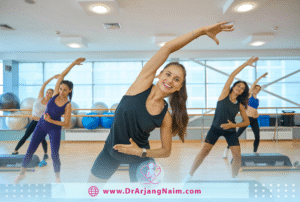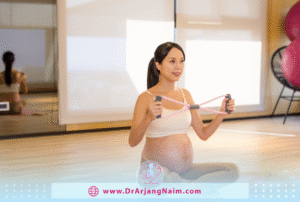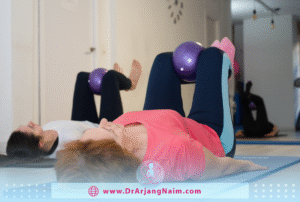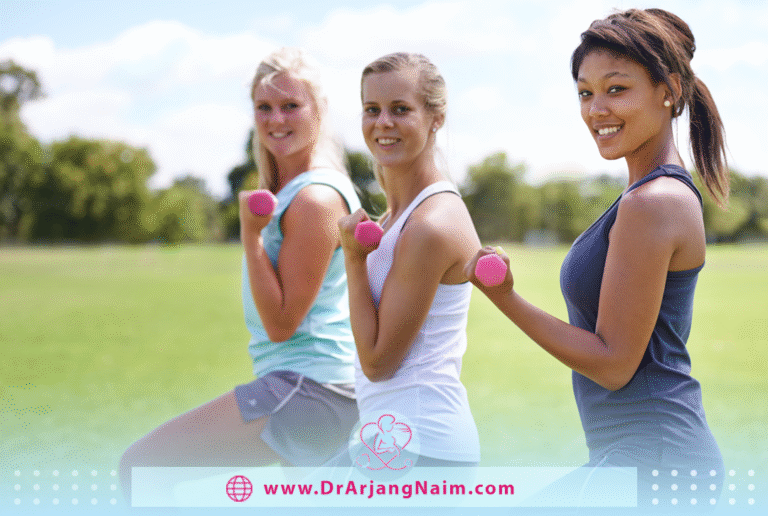Women’s health is the backbone of healthy societies and dynamic families. Among the numerous factors that influence women’s health and quality of life, regular exercise holds a particularly significant place. Physical activity is not merely about maintaining physical fitness; rather, it is a vital long-term investment in both physical and mental health, bringing countless benefits to women from adolescence through their golden senior years.
Why Is Exercise Crucial for Women?
In today’s world, as sedentary lifestyles become more prevalent, women are increasingly at risk of developing chronic diseases. Many of these conditions, from heart disease to osteoporosis, diabetes, and mental health issues, can be largely prevented or managed with regular exercise. Throughout their lives, women’s bodies undergo unique hormonal and physical changes that require specific attention to health and well-being. Exercise not only helps the body adapt to these changes but also plays a key role in strengthening the body’s resistance, boosting energy levels, and improving overall quality of life.

General Benefits of Exercise for All Women
Regardless of age or life stage, regular exercise provides a wide range of fundamental benefits for women’s health.
Cardiovascular Health
Cardiovascular diseases, including stroke and heart attack, are a leading cause of death in women. Regular exercise, especially aerobic exercise, helps strengthen the heart muscle, lowers blood pressure, improves cholesterol levels, and enhances blood circulation. These factors significantly reduce the risk of developing heart disease.
Bone Health and Osteoporosis Prevention
Due to hormonal changes, particularly after menopause, women are prone to osteoporosis. Weight-bearing exercises, such as walking, running, dancing, and weightlifting, stimulate bones to become stronger and help maintain or even increase bone density, which reduces the risk of fractures in later years.
Weight Management and Improved Metabolism
Regular exercise helps burn calories, build lean muscle mass, and increase the body’s metabolic rate. This is crucial in preventing and managing obesity, which is itself a risk factor for many diseases, including type 2 diabetes, heart disease, and certain cancers. Improved insulin sensitivity is another benefit of exercise that plays a crucial role in regulating blood sugar levels.
Mental Health and Stress Reduction
Exercise is a natural stress reliever and anxiety reducer. Physical activity leads to the release of endorphins, which improve mood and reduce symptoms of depression and anxiety. Additionally, regular exercise can help improve the quality of sleep, which is itself a crucial factor in maintaining mental health.
Immune System Boost
Moderate and regular physical activity can strengthen the body’s immune system and increase its resistance to infections and diseases. This means getting sick less often and recovering faster if you do fall ill.

Exercise During Adolescence and Young Adulthood
Adolescence and early adulthood are crucial periods for developing healthy habits and laying the foundations for future health.
Building Strong Foundations
This is a peak time for bone growth and the achievement of maximum bone mass. Teenage girls who exercise regularly build stronger bones, which will serve as a reserve for later in life and help prevent osteoporosis in the future.
Hormonal Balance and Menstrual Health
Regular exercise can help regulate menstrual cycles, reduce symptoms of premenstrual syndrome (PMS) like mood swings, bloating, and fatigue, and lessen the severity of menstrual pain.
Positive Body Image and Self-Esteem
Participating in sports and physical activities can help young girls and women develop a healthier, more positive body image and boost their self-esteem. This is especially important during a period when body image issues can be challenging.
Establishing Healthy Habits
Starting exercise at a young age increases the likelihood of sticking with it throughout life, which is a long-term benefit for overall health.

Exercise During Reproductive Years and Pregnancy
For many women, their reproductive years come with unique experiences, from trying to conceive to going through pregnancy and its aftermath. Exercise plays a vital role during these stages.
Fertility and Reproductive Health
For women planning to conceive, regular exercise at a healthy weight can help improve hormonal balance and increase the chances of pregnancy, especially in cases of Polycystic Ovary Syndrome (PCOS), which is linked to insulin resistance and hormonal imbalances.
Exercise During Pregnancy
- Reduced Pregnancy Discomforts: Physical activity can help alleviate common pregnancy discomforts, including back pain, fatigue, swelling, and constipation.
- Weight Gain Management: Exercise helps pregnant women achieve healthy weight gain and prevents excessive weight gain, which can lead to complications like gestational diabetes and pre-eclampsia.
- Preparation for Childbirth: Strengthening your pelvic floor and core muscles can improve the strength and stamina required for labor and delivery.
- Mood Improvement: Exercise can help alleviate anxiety and depression during pregnancy, while also boosting a sense of overall well-being.
- Safety: With a doctor’s consultation, most women can continue moderate-intensity exercise throughout pregnancy. Walking, swimming, yoga, and modified Pilates are excellent options for exercise.
Postpartum Recovery
After childbirth, exercise helps women regain their strength and stamina, shed excess pregnancy weight, combat fatigue, and reduce the risk of postpartum depression. Pelvic floor exercises are very important for restoring bladder and vaginal function.

Exercise During Perimenopause and Menopause
Menopause is accompanied by significant hormonal changes that can affect a woman’s physical and mental health. Exercise during this period not only helps manage symptoms but also reduces the risk of age-related diseases.
Managing Menopause Symptoms
Exercise can help reduce hot flashes, night sweats, mood swings, and sleep problems, which are common symptoms of menopause.
Combating Bone Loss
As mentioned, menopause leads to a rapid decline in estrogen, resulting in a loss of bone density. Weight-bearing and resistance training during this period is crucial to prevent osteoporosis and fractures.
Protecting Cardiovascular Health
After menopause, women’s risk of cardiovascular disease increases. Regular exercise helps maintain heart health, manage blood pressure and cholesterol, and prevent atherosclerosis.
Control Weight Gain and Metabolic Changes
As women age and their metabolism slows during menopause, many experience weight gain, particularly in the abdominal area. Exercise helps maintain muscle mass and burn fat, preventing unwanted weight gain.
Maintain Muscle Mass and Strength
As we age, muscle mass gradually decreases (sarcopenia). Strength training is vital for maintaining muscle mass, improving strength and balance, and thus reducing the risk of falls and injuries in later life.
Improve Mental Health
Exercise serves as an effective strategy for coping with anxiety and depression, which can be exacerbated during menopause, and improves quality of life.
Recommended Types of Exercise for Women
To maximize the benefits of exercise, it’s recommended to combine different types of physical activities.
Aerobic Exercises (Cardio)
These include brisk walking, running, swimming, cycling, dancing, and aerobics. These exercises are beneficial for cardiovascular health, weight management, and increasing stamina. A minimum of 150 minutes of moderate-intensity aerobic activity or 75 minutes of vigorous-intensity activity per week is recommended.
Strength Training (Resistance Training)
This involves weightlifting, resistance band exercises, bodyweight exercises (such as squats, push-ups, and lunges), and utilizing gym equipment. These exercises are crucial for strengthening muscles and bones, improving metabolism, and preventing muscle mass loss. At least two strength training sessions per week are recommended for all major muscle groups.
Flexibility and Balance Exercises
These include yoga, Pilates, and stretching. These exercises help improve joint range of motion, reduce the risk of injury, and enhance balance, which becomes more important with age.

Pelvic Floor Exercises
These are particularly important for women at all life stages, including during pregnancy and postpartum, as well as during menopause. Strengthening the pelvic floor muscles can help prevent and manage urinary incontinence, as well as improve sexual function.
Practical Tips and Considerations
To start or continue a regular exercise program, keeping the following tips in mind can be helpful:
- Consistency is key: It’s better to exercise a little bit every day than to work out intensely once a week.
- Listen to your body: avoid overexertion and pay attention to signs of fatigue or discomfort.
- Consult a professional: Before starting any new exercise program, especially during pregnancy or if you have underlying health conditions, consult your doctor or a physical therapist for guidance.
- Find enjoyable activities: Choosing an exercise you genuinely enjoy increases your likelihood of sticking with it.
- Start small and gradually increase: You don’t have to be a professional athlete from day one. Begin with small goals and gradually increase the intensity and duration of your activities.
The bottom line
Regular exercise is an essential component of a healthy lifestyle for women at all stages of life. From building strong bones in adolescence to managing the challenges of pregnancy and alleviating menopause symptoms, its benefits are numerous and profound. Investing in physical activity not only aids physical health but also boosts mental resilience and improves overall quality of life. Given the unique needs of women’s bodies, choosing the right types of exercise and maintaining consistency is a sure path to ensuring a healthier, happier, and more energetic life. Every small step on the path to physical activity is a big leap toward long-term health and well-being for women.
Additional questions
- How can I maintain my motivation for regular exercise, especially with a busy schedule?
Maintaining motivation often depends on making exercise enjoyable and manageable. Find a workout buddy for accountability or join a group class that offers social interaction to stay motivated. Consider breaking up your exercise into shorter periods throughout the day to make it more manageable. Also, focus on the positive feelings after exercise, not just the effort, and reward yourself for consistency.
- How does nutrition complement exercise for optimal women’s health, particularly for bone density and hormonal balance?
Nutrition is crucial! For bone density, ensure adequate intake of calcium and Vitamin D, which work together to build and maintain strong bones. For hormonal balance, a balanced diet rich in whole foods, healthy fats, and fiber can help regulate hormones. Limiting processed foods and excessive sugar can also significantly reduce inflammation and support overall endocrine health, working hand-in-hand with the benefits of exercise.
- Beyond physical changes, how can exercise impact a woman’s confidence and overall empowerment in her daily life?
Exercise significantly boosts confidence by demonstrating the body’s capabilities and fostering a sense of accomplishment. Achieving fitness goals, no matter how small, can lead to increased self-efficacy in other areas of life.
- How does targeted exercise influence insulin sensitivity and androgen levels in women with Polycystic Ovary Syndrome (PCOS)?
Exercise, especially a combination of aerobic and resistance training, significantly increases insulin sensitivity in women with PCOS by improving insulin signaling and reducing hyperinsulinemia. The decrease in blood insulin levels, in turn, reduces androgen production in the ovaries, which is a primary cause of PCOS symptoms like hirsutism and menstrual irregularities. This metabolic improvement helps regulate hormonal cycles and reduces the inflammatory burden.
- What are the established mechanisms through which regular exercise impacts the reduction of breast cancer risk?
Regular exercise acts through several mechanisms to reduce the risk of breast cancer. These mechanisms include lowering hormone levels, such as estrogen and insulin, improving immune system function, and reducing chronic inflammation. For breast cancer survivors, exercise helps manage treatment side effects such as cancer-related fatigue, improves lymphedema, maintains bone density, and enhances overall quality of life.
References
https://www.sutterhealth.org/health/health-benefits-of-exercise-for-women
https://www.mayoclinic.org/healthy-lifestyle/fitness/in-depth/exercise/art-20048389
https://www.cwcare.net/importance-exercise/
https://www.healthline.com/nutrition/10-benefits-of-exercise




